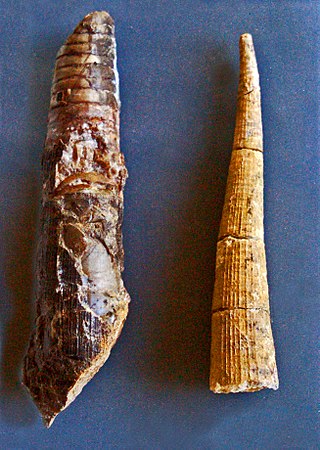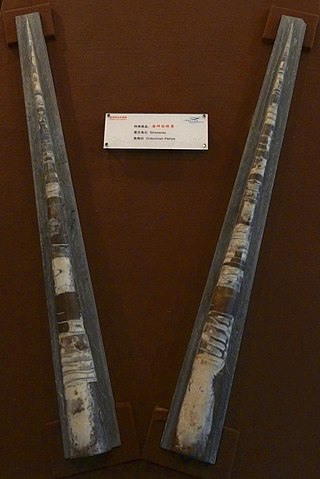Related Research Articles

Nautiloids are a group of marine cephalopods (Mollusca) which originated in the Late Cambrian and are represented today by the living Nautilus and Allonautilus. Fossil nautiloids are diverse and speciose, with over 2,500 recorded species. They flourished during the early Paleozoic era, when they constituted the main predatory animals. Early in their evolution, nautiloids developed an extraordinary diversity of shell shapes, including coiled morphologies and giant straight-shelled forms (orthocones). Only a handful of rare coiled species, the nautiluses, survive to the present day.

Orthoceras is a genus of extinct nautiloid cephalopod restricted to Middle Ordovician-aged marine limestones of the Baltic States and Sweden. This genus is sometimes called Orthoceratites. Note it is sometimes misspelled as Orthocera, Orthocerus or Orthoceros.

Endocerida is an extinct nautiloid order, a group of cephalopods from the Lower Paleozoic with cone-like deposits in their siphuncle. Endocerida was a diverse group of cephalopods that lived from the Early Ordovician possibly to the Late Silurian. Their shells were variable in form. Some were straight (orthoconic), others curved (cyrtoconic); some were long (longiconic), others short (breviconic). Some long-shelled forms like Endoceras attained shell lengths close to 6 metres (20 ft). The related Cameroceras is anecdotally reported to have reached lengths approaching 9 metres (30 ft), but these claims are problematic. The overwhelming majority of endocerids and nautiloids in general are much smaller, usually less than a meter long when fully grown.

Orthocerida, also known as the Michelinocerida, is an order of extinct orthoceratoid cephalopods that lived from the Early Ordovician possibly to the Late Triassic. A fossil found in the Caucasus suggests they may even have survived until the Early Cretaceous, and the Eocene fossil Antarcticeras is sometimes considered a descendant of the orthocerids although this is disputed. They were most common however from the Ordovician to the Devonian.
Cameroceras is an extinct genus of endocerid cephalopod which lived in equatorial oceans during the entire Ordovician period. Like other endocerids, it was an orthocone, meaning that its shell was fairly straight and pointed. It was particularly abundant and widespread in the Late Ordovician, inhabiting the shallow tropical seas in and around Laurentia, Baltica and Siberia.
The Ellesmerocerida is an order of primitive cephalopods belonging to the subclass Nautiloidea with a widespread distribution that lived during the Late Cambrian and Ordovician.
Mcqueenoceras is an extinct genus of early endocerid, a nautiloid from the Floian epoch of the late early Ordovician period. It was similar in overall form to Clitendoceras, from which it may have been derived. Mcqueenoceras, like Clitendoceras, has ventral siphuncle but the endocones are thicker on the ventral side and thinner on the dorsal. Also the sutures in Mcqueenoceras retreat rearward, forming lobes as they cross the venter. The type species is Mcqueenoceras jeffersonense, named by E.O. Ulrich and A.F. Foerste in 1935, and it is known from Missouri and New York. In 1956, Rousseau H. Flower named two other species, M. cariniferum and M. ventrale, both known from Maryland.
Ectenolites is a genus of small, slender, cylindrical Ellesmeroceratids that resemble Ellesmeroceras but are smaller and proportionally narrower. Septa, as typical for ellesmerocerids, are close spaced with shallow lobes on either flank. The body chamber is proportionally long, the shell itself slightly compressed. The dorsal side at the beginning of the shell, opposite the aperture and body chamber, is strongly convex so to produce a sense of endogastric curvature with the apex and siphuncle aligned.
Clarkoceras is a genus of breviconic ellesmerocerid cephalopods, one of only two genera known to have crossed from the Late Cambrian, Trempealeauan, into the Early Ordovician, Gasconadian. ; the other being Ectenolites.

The Actinocerida are an order of generally straight, medium to large cephalopods that lived during the early and middle Paleozoic, distinguished by a siphuncle composed of expanded segments that extend into the adjacent chambers, in which deposits formed within contain a system of radial canals and a narrow space along the inner side of the connecting ring known as a paraspatium. Septal necks are generally short and cyrtochoanitic, some being recumbent, some hook shaped. Most grew to lengths of about 60 to 90 cm but some, like the Huroniidae of the Silurian grew significantly larger.
Jangziceras is a genus of fossil nautiloid cephalopods from the Middle Silurian of southern China belonging to the Orthocerida incertae sedis, its familial association undetermined. The type is Jangziceras sichuanense Lai Chai-Geen. Its description falls within the characters of the Orthocerida.

Kionoceras is an extinct nautiloid cephalopod genus included in the orthocerid family Kionoceratidae with scattered worldwide distribution from the Middle Ordovician to the Lower Permian. Kionoceratids are orthocerids with prominent longitudinal ornamentation on their shells, sometimes augmented by secondary transverse ornamentation. Orthocerids are, of course, prehistoric nautiloides with generally straight and elongate shells, mostly with central or subcentral siphuncles.
Hoeloceras is an extinct orthoconic nautiloid cephalopod from the upper Ordovician, generally included in the Actinocerida. Nautiloids are a subclass of shelled cephalopods that were once diverse and numerous but are now represented by only a couple of genera, Nautilus and Allonautilus.

Sinoceras is an extinct genus of nautiloids from China included in the family Orthoceratidae that lived from the middle Ordovician until the Devonian. The type species, S. chinense, was originally described as "Orthoceras chinense," but then was promoted by Shimizu and Obata to its own genus, Sinoceras, in 1935.
Richmondoceras is an extinct genus of actively mobile carnivorous cephalopods, essentially a Nautiloid, that lived in what would be North America during the Ordovician and Silurian from 449.5—443.7 mya, existing for approximately 5.8 million years.

Orthoceratoidea is a major subclass of nautiloid cephalopods. Members of this subclass usually have orthoconic (straight) to slightly cyrtoconic (curved) shells, and central to subcentral siphuncles which may bear internal deposits. Orthoceratoids are also characterized by dorsomyarian muscle scars, extensive cameral deposits, and calciosiphonate connecting rings with a porous and calcitic inner layer.
Plectronoceratoidea is a superorder or subclass containing primitive nautiloids from the Late Cambrian and Early Ordovician. This group is best considered a paraphyletic grade of early cephalopods, as it contains the ancestors of subsequent post-Cambrian cephalopod orders.
Cartersoceras is a genus of nautiloid cephalopods placed in the Orthocerid family Baltoceratidae, established by Rousseau Flower (1964), for species formally included in part in Murrayoceras, and in part in "Sacotoceras". This group is typical of Murrayoceras in all features except that the siphuncle segments are convex in outline. It is known from the Middle Ordovician of the eastern United States.
The Folkeslunda Limestone is a thin limestone and mudstone geologic formation of Sweden. The formation crops out on the island of Öland to the east of Kalmar, where Folkeslunda is located. Other exposures of the formation are in Dalarna, Jämtland and Östergötland. The Folkeslunda Limestone was deposited in an open marine environment with an estimated water depth of 150 to 200 metres in a eustatically transgressive phase.
Eothinoceratidae is a family of Lower Ordovician nautiloid cephalopods included in the Cyrtocerinida. The family was originally established for the genus Eothinoceras.
References
- Chen Ting Yan, 1987. Ordovician Nautiloids from Xainza: Nanjing Institute of Geology and Paleontology Series 11:133-191,1987.